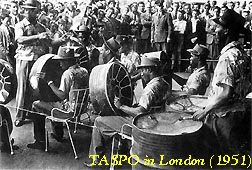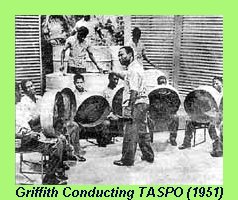Steelband 1950 - 1959
The 1950s began with all pans supported around the necks of players. The primary focus of the steelband was to perform on the streets during Carnival and all panmen supported their instruments while parading. Panmen would convene approximately two months before Carnival to learn and rehearse their parts; this was referred to as practice. Each band had a leader/arranger who may or may not have had any formal musical education. For the most part, panmen had none and depended on their hearing for memorizing the music.
 In 1950, the first steelband organization, the National Association of Trinidad & Tobago Steelbandmen, was formed with Sidney Gollop as its first President. In 1951, the steelband had made such rapid progress that a group of the eleven leading panmen was selected to perform at the Festival of Britain which was held at Southbank, London. This group was called the Trinidad All Steel Percussion Orchestra (TASPO) and included:
Sterling Betancourt (Crossfire);
Belgrave Bonaparte (Southern Symphony); Philmore Davidson (City Syncopators);
Andrew De LaBastide (Hill 60);
Orman Haynes (Casablanca);
Elliott Mannette (Invaders);
Granville Sealey (Tripoli);
Winston Simon (Tokyo);
Dudley Smith (Rising Sun);
Theophilus Stephens (Free French); and Anthony Williams (North Stars). The musical director was Lt. Joseph Nathaniel Griffith (shown in photo below) of the Police Band and the official tuners were Betancourt, Davidson, De LaBastide, and Mannette. Granville Sealey dropped out of the band early and Carlton Roach (Sun Valley) was selected to replace him. TASPO sailed to England on the SS San Mateo on July 6, 1951. Roach never made it to England as he was let off the ship in Martinique after falling ill. TASPO toured Great Britain playing at dances and concerts in cities such as London, Newcastle, Leeds, and Manchester. The group returned to Trinidad on December 12, 1951, minus Betancourt who stayed in London to continue his pan career. Click here for a recount of the 1951 experience by one of the participants, Sterling Betancourt.
In 1950, the first steelband organization, the National Association of Trinidad & Tobago Steelbandmen, was formed with Sidney Gollop as its first President. In 1951, the steelband had made such rapid progress that a group of the eleven leading panmen was selected to perform at the Festival of Britain which was held at Southbank, London. This group was called the Trinidad All Steel Percussion Orchestra (TASPO) and included:
Sterling Betancourt (Crossfire);
Belgrave Bonaparte (Southern Symphony); Philmore Davidson (City Syncopators);
Andrew De LaBastide (Hill 60);
Orman Haynes (Casablanca);
Elliott Mannette (Invaders);
Granville Sealey (Tripoli);
Winston Simon (Tokyo);
Dudley Smith (Rising Sun);
Theophilus Stephens (Free French); and Anthony Williams (North Stars). The musical director was Lt. Joseph Nathaniel Griffith (shown in photo below) of the Police Band and the official tuners were Betancourt, Davidson, De LaBastide, and Mannette. Granville Sealey dropped out of the band early and Carlton Roach (Sun Valley) was selected to replace him. TASPO sailed to England on the SS San Mateo on July 6, 1951. Roach never made it to England as he was let off the ship in Martinique after falling ill. TASPO toured Great Britain playing at dances and concerts in cities such as London, Newcastle, Leeds, and Manchester. The group returned to Trinidad on December 12, 1951, minus Betancourt who stayed in London to continue his pan career. Click here for a recount of the 1951 experience by one of the participants, Sterling Betancourt.
 While panmen worked tirelessly at developing the only melodic, steel percussion instrument invented in the 20th century, the steelband was not openly embraced by the citizenry. Panmen generally came from the poorer, lesser-educated, Black segments of the population and their music became synonymous with their plight; steelband music was the poor Black man's music. In reality, steelbands attracted many lawbreakers and associating with a band was not considered socially acceptable. Many panmen belonged to gangs and, as a result, steelbands were perceived by most people as extensions of these gangs. There were numerous fights among steelbands that, in many instances, led to bloodshed with the use of weapons (such as knives, razors, and cutlasses) and missiles (such as bottles and stones). These violent clashes were reflected in the calypsoes of the time (See Calypso in the 1950s).
While panmen worked tirelessly at developing the only melodic, steel percussion instrument invented in the 20th century, the steelband was not openly embraced by the citizenry. Panmen generally came from the poorer, lesser-educated, Black segments of the population and their music became synonymous with their plight; steelband music was the poor Black man's music. In reality, steelbands attracted many lawbreakers and associating with a band was not considered socially acceptable. Many panmen belonged to gangs and, as a result, steelbands were perceived by most people as extensions of these gangs. There were numerous fights among steelbands that, in many instances, led to bloodshed with the use of weapons (such as knives, razors, and cutlasses) and missiles (such as bottles and stones). These violent clashes were reflected in the calypsoes of the time (See Calypso in the 1950s).
In the early 1950s, young, middle-class, college-educated, aspiring panmen avoided the hostile environment that had been created by existing steelbands and formed their own bands. Three such bands were Dixieland, Silver Stars, and Saigon. Dixieland was led by Curtis Pierre who was a student at St. Mary's College and was able to attract some of his schoolmates. Silver Stars was led by Edgar "Junior" Pouchet who also attended St. Mary's and was able to attract St. Mary's as well as Queen's Royal College students. Saigon, which later became Starlift, included students from Queen's Royal, St. Mary's, and Fatima Colleges. The three bands were all located in Port-of-Spain and, with the support of the members' schoolmates, families, and friends, were very instrumental in gaining the steelband acceptance by the middle-class and upper echelons of Trinidad society.
In 1952, after strong resistance from the Music Association, steelbands were allowed to compete at the biannual Music Festival for the Hope-Ross Challenge Cup. The association had opposed attempts by the steelbands to play classical music. Lacking an adequate concert hall, the festival was conducted in cinemas such as Globe and Roxy in Port-of-Spain.
During the mid-1950s, the art form exploded. Pans went from single units to multiple units with improved sound. Although the melody was still carried by a single pan (tenor or first-pan), background music was provided by the second-pan (two pans), the guitar-pan (two pans), and the bass (three to four drums). Neville Jules (All Stars) developed the twin-bass and Ellie Mannette (Invaders) developed a second-pan (double-second) that would remain a standard into the 21st century. With these innovations, the steelband evolved from an orchestra of single-drum instruments, supported around the necks of panmen, to one comprised of multiple-drum instruments with the octaves of a piano and supported on metal frames with wheels for ease in parading the streets. Anthony Williams (North Stars) was generally accepted as the first band-leader to use wheeled stands. The increased range of the steelband allowed for the adaptation of classical music and popular American songs to the calypso beat. The Invaders and All Stars Steelbands were the leading pioneers in this movement. Interpretations by Invaders that became recording hits included "Liebestraume" (Franz Liszt), "Melody in F" (Anton Rubinstein), "Hawaiian Wedding Song," "Come Back to Sorrento," "With A Song in My Heart," and "Softly as A Morning Sunrise." Successful recordings by All Stars were "Intermezzo," "Barcarolle," and "Minuet in G."
In 1956, a 15-minute, 16mm documentary entitled Music From Oil Drums was filmed by Peter and Toshi Seeger, in collaboration with Kim Loy Wong of the HiLanders Steelband. The film is a detailed documentation of how steeldrums are made and played. In 1958, the film won the "Chris" award for excellence of Production, Information and Education and was also nominated for the EFLA (Educational Film Library Association) award in 1959. The film was produced in conjunction with an instructional manual, The Steel Drums of Kim Loy Wong co-authored by Kim Loy Wong and Pete Seeger, and was believed to be the first ever book to document how to make and play the steelpan.
In 1957, relations among some bands remained strained but that did not deter 13-year old Ray Holman from joining Invaders who, up to that time, had gained an unfavorable reputation from their previous violent conflicts with other bands. A first-year student at Queen's Royal College, Holman was instrumental in changing the band's image and would go on to make a significant impact on steelband music.
One of the most renown panmen of this decade was Emmanuel Riley, of the Invaders Steelband. A soloist of extreme talents, Riley was not only an expert pan tuner, but also a master improvisor on any instrument. He established a "jazzy" approach to playing that characterized the unique sound of the Invaders Steelband. His improvisations in the 1959 Invaders' recordings "Liebestraume" and "Melody in F" set a standard for pan soloists that has never been surpassed. The musical interpretations of Invaders were so well-received by the public that steelbands from the western (West) section of Port-of-Spain began to emulate their styling. Eventually, this jazzy interpretative style became synonymous with most of the popular steelbands from the West: Invaders; Starlift; Symphonettes; Crossfire; Silver Stars. Other panmen who made significant contributions to the furtherance of pan music during this decade were player Kelvin Hart and ambassadors Kelvin Dove and Kim Loy Wong.
The following are the results of the Steelband Music Festivals in the 1950s:
| STEELBAND MUSIC FESTIVAL WINNERS: 1950s | ||
|---|---|---|
| YEAR | WINNING STEELBAND | SELECTION |
| 1952 | Boys Town | You Are My Heart's Delight |
| 1954 | Southern All Stars | Anna (Vato Roman & F. Giordano) |
| 1956 | Katzenjammers | The Breeze and I (Ernesto Lecuona) |
| 1958 | No Competition |